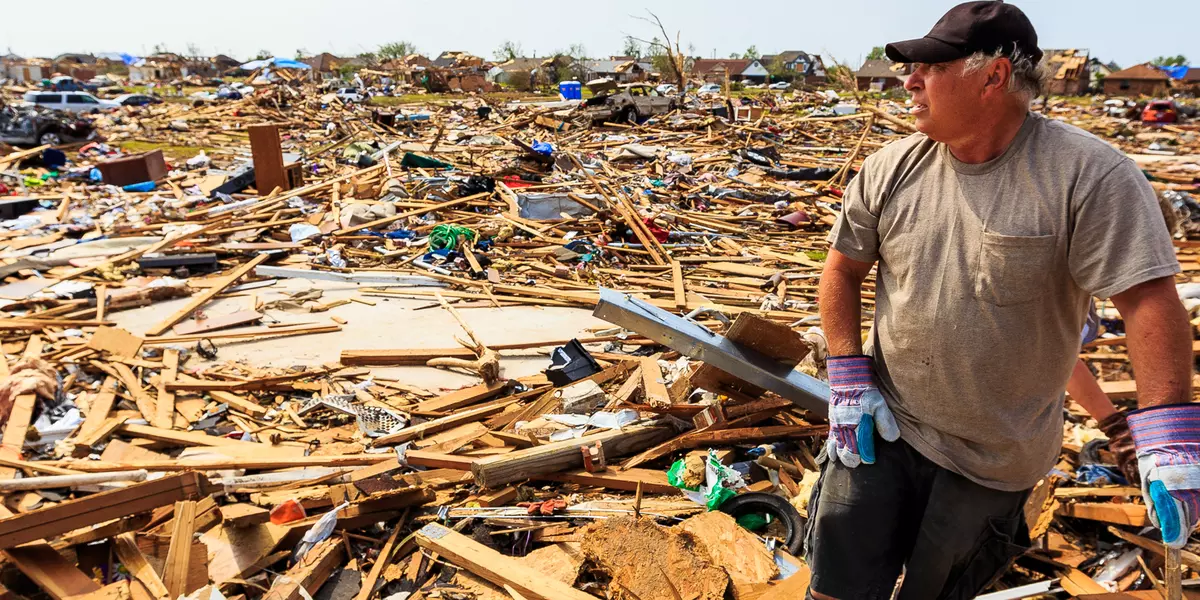
Clinton Anderson stands where his kitchen once was and looks over debris that was his neighborhood until an EF-5 tornado leveled it on May 20, 2013.
Helping to Build a Nation of Resilient Communities
Every year, hundreds of U.S. communities take a beating. These are the towns, cities, counties and tribal areas that suffer the casualties, damage and disruptions inflicted by hazards. Recoveries may span months to years, and in some severely stricken communities, the job of rebuilding may stall and never be completed.
Collectively, the annual tally of local and regional losses also imposes a tremendous national toll. Over the last 10 years, natural disasters have caused, on average, $62 billion in damages and killed more than 550 people annually. From 2011 to 2013, the federal government spent an estimated $136 billion on disaster relief.
The message is as clear as an alarm bell: Every U.S. community faces the risk of disaster. (For evidence, see the map showing the almost 2,000 disaster declarations between 1964 and 2014 and the map of severe weather events in 2014.)
It's not if but when.
The size of that risk, however, can be reduced significantly, before the unpredictable day of reckoning arrives. When a river pours over its banks, say, or a hurricane turns inland, the consequences need not be disastrous, if the affected communities have acted to improve their resilience—their capacity to absorb a shock and bounce back up ... and forward.
Guide to Community Resilience
Helping to build this capacity was the impetus for the Community Resilience Planning Guide for the Built Environment and Infrastructure Systems, prepared by the National Institute of Standards and Technology (NIST) with experts and stakeholders from around the nation. First issued in October 2015, the planning guide details a six-step, integrated approach that communities can follow to achieve a more resilient, less disaster-prone future.
“Think of resilience as both preventive and restorative care—but for buildings and infrastructure facing disaster risks,” explains Therese McAllister, leader of NIST’s community resilience program. "These structures and support systems underpin the social and economic fabric of their community.
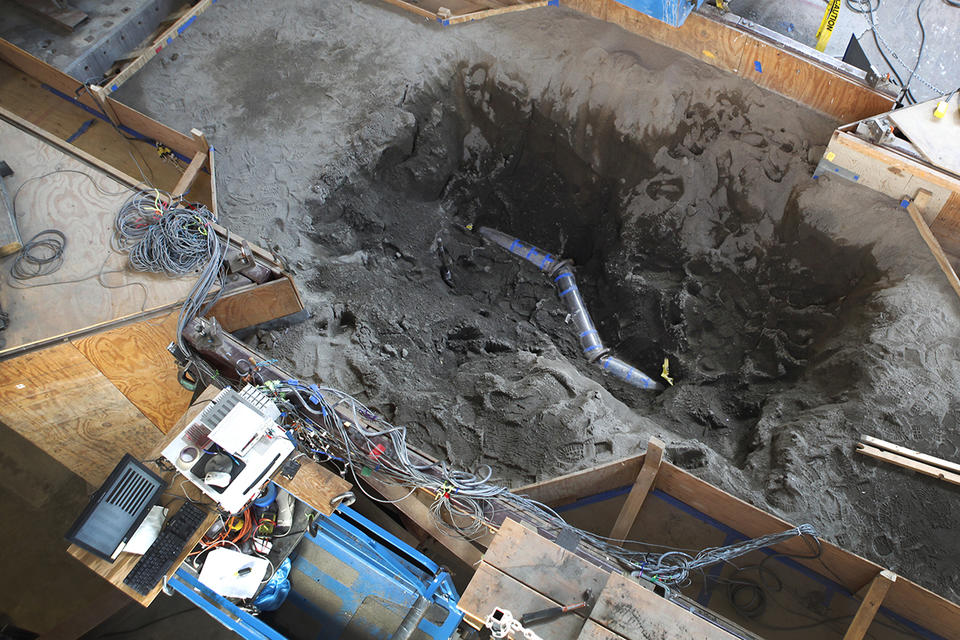
In an example of disaster resilience research at work, Cornell University engineers test a novel earthquake-resilient pipeline designed to better protect southern California’s water utility network.
“So, by strengthening the resilience of its built environment—so that it can be relied on when most needed—a community is better able to maintain vital functions during an emergency and to recover efficiently so that ‘normal life’ can resume within a reasonable time after the hazard has passed.
Floods, tornados, earthquakes and other natural hazards can’t be prevented. And because of climate change, some risks will grow. Increased flooding may imperil coastal counties where more than half of Americans live or work, and the threat of more frequent and more intense extreme weather events may rise for communities where tens of millions of Americans live.
Who’s Putting the Community Resilience Planning Guide to Work?
NIST’s Community Resilience Planning Guide for Buildings and Infrastructure Systems offers a six-step process that provides a practical and flexible approach to help communities improve their resilience by setting priorities and allocating resources appropriately. Since its release in October 2015, the following are some of the ways communities and organizations across the nation have put it to work:
- Partnered with the U.S. Department of Homeland Security, Fort Collins, Colorado, officials are following the guide to conduct a general resilience assessment of their city.
- To facilitate resilience in the aftermath of severe floods in 2013, Boulder County, Colorado, incorporated the guide and its six steps into a Resilient Performance Design Standard that is used to evaluate proposed structural and infrastructural additions, repairs and improvements.
- San Diego, California, has teamed with its neighbor, Tijuana, Mexico, to use the guide to define ways for reducing the physical and economic impacts of a magnitude 6.9 earthquake.
- The Delaware Department of Transportation is employing the guide to assess state highways for potential flood risks and recommend measures to counter them.
- Clemson University’s Glenn Department of Civil Engineering has integrated the guide into its curriculum, a novel application that includes having students plan, develop and implement field projects for improving resiliency in the state of South Carolina and in other nations (such as Haiti) as part of the Clemson Engineers for Developing Countries program.
Then, there’s the risk of technological or human-caused mishaps—the chemical spills and train derailments, for example, that make headlines all too often.
But through planning, prioritization and sustained follow-through efforts, as detailed in the new guide, communities can lessen the impacts of these shocks and shorten the road to full recovery.
“The guide focuses on the built environment through the lens of social and economic needs,” says NIST Community Resilience Fellow Jay Wilson, who is the hazard mitigation program manager for Clackamas County, Oregon. “These needs frame community expectations for how buildings and infrastructure will perform during and after a hazard event. This provides the context for making informed decisions on how to improve community resilience.”
Be Proactive
For many communities, most hazard events—especially extreme weather events like floods and tornados—have been regarded as random, overpowering acts of God. Seemingly defenseless, stricken communities responded reactively, focusing almost entirely on emergency response activities, followed by clean up and recovery.
In contrast, community resilience, which spans from pre-disaster preparation and mitigation to post-disaster recovery, is proactive, continuous and integrated into the fabric of community planning. Organizations ranging from the United Nations to a growing number of governments and organizations at every level are promoting community resilience as the best approach to managing the risk of disaster.
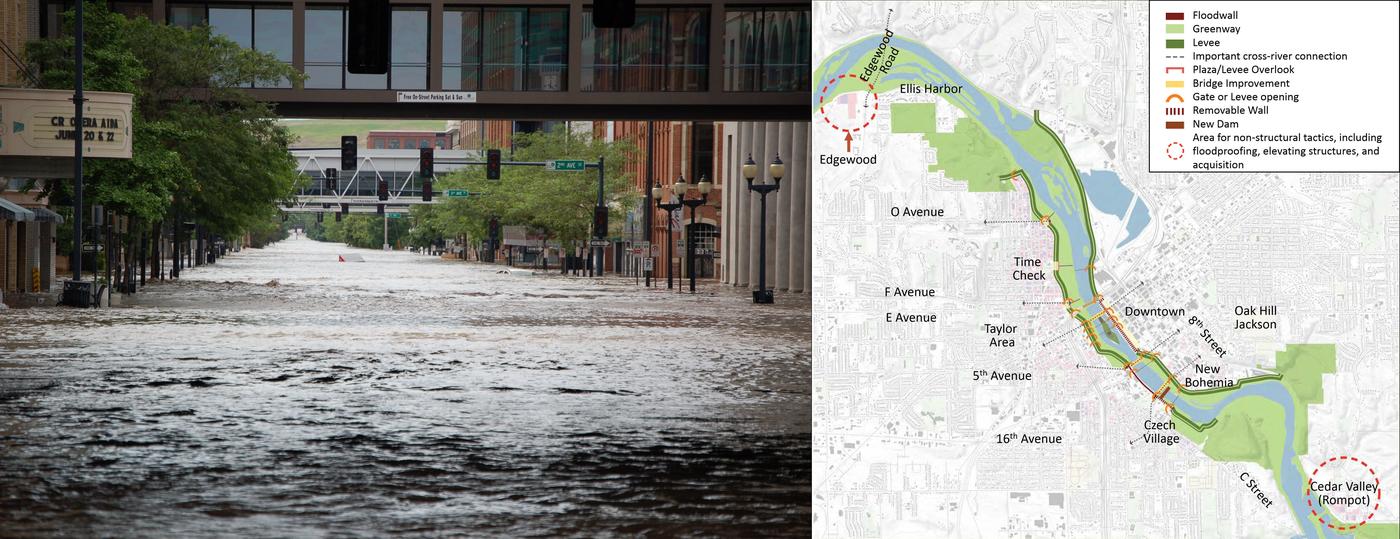
Downtown Cedar Rapids, Iowa, during the 2008 floods (left) and the Cedar Rapid Resilience Plan (right) developed in response to the disaster.
“The primary goal of hazard reduction has shifted from one solely aimed at protecting people to one that also seeks to protect the built environment to the extent necessary to allow rapid recovery,” explains NIST Community Resilience Fellow Chris Poland, a consulting engineer and former chairman of Degenkolb Engineers.
Resource allocations lag this change in perspective, however. Worldwide, nearly $9 is spent on disaster response, recovery and rehabilitation for every $1 spent on “reducing and managing the risks before they manifest themselves as disasters,” the Zurich Flood Resilience Alliance reported in 2014.
The good news is that in the United States, proactive, pre-disaster efforts are gaining momentum. The Federal Emergency Management Agency reports that nearly 23,000 U.S. communities—inhabited by more than 82 percent of the nation's population—have disaster mitigation plans. Effective mitigation measures will, for example, protect a building from flooding. But factoring resilience into disaster risk management efforts will help to ensure that the structure also has power and water during recovery.
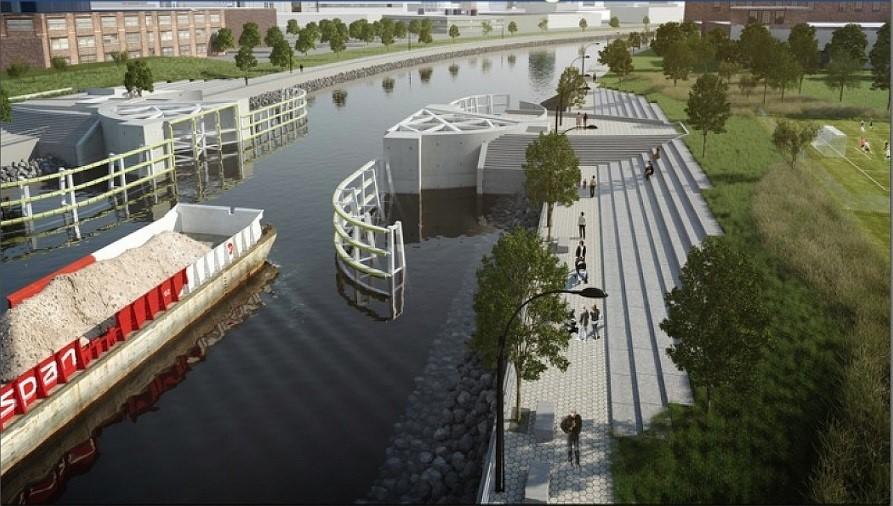
An artist’s rendition of a proposed storm surge barrier along Newtown Creek in New York City.
Translating Concept to Practice
While more and more organizations—domestic and international, public and private—are promoting community resilience to lower disaster tolls, reducing this important concept to practice remains a work in progress. A recent review of 692 articles “using the resilience concept” found only 17 that included some approach to measurement, indicating, according to the authors, “limited agreement about how to operationalize the concept.”
Add NIST’s planning guide to the “operationalize” column. It begins to connect the dots between good idea and constructive action. In addressing the how of resilience, the planning guide is both a self-help tool for communities and a valuable complement to other efforts promoting proactive disaster risk management.
“It’s a tool that wrestles the concept of resilience to the ground,” Wilson says. “It helps communities frame their decisions in a long-term context so that they are thinking about how their decisions and actions will play out over the next several generations.”
Big Picture
NIST has learned a great deal about—and from—disasters. Since 1971, institute researchers have studied more than 50 disasters and building failures. “Lessons learned” from these investigations point the way to advances in practices, standards and codes that reduce the potential for similar catastrophes in the future. These studies and related NIST laboratory research—much of it focused on developing standard methods to predict and assess how structures perform under high winds and other hazard-imposed stresses—were springboards for the institute’s major push to boost community resilience.
Another catalyst has been NIST’s participation as the lead agency in the National Earthquake Hazards Reduction Program (NEHRP)—a four-agency partnership devoted to long-term earthquake risk reduction. Improving the earthquake resilience of communities nationwide is one of NEHRP’s three major goals.
Additionally, NIST has been designated by Congress to serve as the lead agency for the National Windstorm Impact Reduction Program (NWIRP). A federal collaboration like NEHRP, NWIRP seeks to increase scientific and technical understanding of windstorms and their hazards, and then use that knowledge to advance tools and technologies that will mitigate the windstorm threat to lives and property.
“Our disaster investigations and our structural and materials research lead to improvements in the safety and performance of buildings during earthquakes, tornados and other hazards,” explains Howard Harary, director of NIST’s Engineering Laboratory. “This work helps to improve structural resilience, but that’s only one part of the community resilience equation.”
So, when it set out to develop the planning guide, NIST enlisted a cadre of experts to address important parts of the complex equation beyond the institute’s core capabilities. The institute appointed Wilson, Poland and nine others to serve as NIST Community Resilience Fellows, outside experts in fields ranging from transportation to communications and from sociology to business continuity. It also initiated a nationwide outreach program, including four regional meetings, to engage diverse stakeholder groups—government officials, emergency managers, planners and architects, utility representatives, insurers and many more—in the planning guide's development.
“This has been a unique effort, even pacesetting,” Poland says. “The guide takes a deep dive into what is needed, during recovery, from the built environment from a social and economic perspective. The result is a hands-on approach that will get communities to look at the big picture.”
What's Inside
The guide’s six-step process starts with the formation of a resilience team drawn from the community and culminates with the development and implementation of resilience strategies that are updated regularly.
The resilience team’s role is to engage representatives of the entire community in a series of efforts that include defining how local buildings and infrastructure systems, such as power, water and transportation, support vital social functions like health care, education and public safety.
This information helps to address critical questions: When do buildings and infrastructure systems that support social functions need to be restored so that recovery is not deferred and the community’s longer-term ability to serve local residents does not deteriorate? And are there suitable temporary measures available to cover the time it takes to make repairs?
Through its integrated approach, the planning guide also reckons with a key, though not always heeded, fact: Disaster impacts development, and development impacts disaster.
Or in the oft-repeated words of hazards research pioneer Gilbert White, who summed up this relationship for one type of hazard: “Floods are ‘acts of God,’ but flood losses are largely acts of man.”
Focus and Persistence
“Resilience planning is not a stand-alone activity,” McAllister explains. “The guide recommends that communities integrate their resilience plans into economic development, zoning and other local planning activities that impact buildings, public utilities and other infrastructure systems that residents rely on for important services.”
Key planning steps include “understanding the social situation”—from demographics to social services and institutions—and “characterizing the built environment”—determining, for example, how buildings and infrastructure support community needs and functions and whether buildings are located in hazard zones. Another critical step in this assessment is determining vulnerabilities stemming from dependencies among buildings and infrastructure systems—such as electric power and communications—which can result in cascading failures, akin to a falling house of cards.
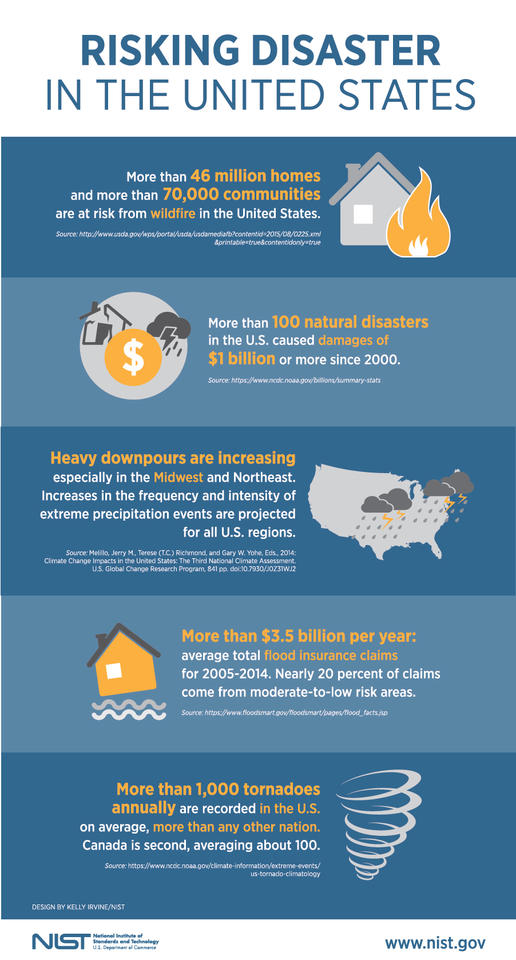
Natural disasters across the United States create many risks to lives and property and have measurable impacts on the economy.
In Oregon, which faces the prospect of a massive Cascadia earthquake that would affect much of the Northwest, “interdependencies between infrastructure systems, especially roads and power, is the biggest issue that we need to focus on,” says Wilson, who helped lead development of Oregon’s resilience plan, the first such statewide undertaking. “The relationship between all of these means that we can't fix a single sector unless we’re fixing them all in unison, which means there is a great deal of complexity in this problem. Any way that we can improve the seismic safety of our power grids and our road networks ahead of time, means less coordination needed to repair these systems, and a better availability of resources to respond to critical areas.”
The two-volume planning guide delves into infrastructural dependencies and distills other instructive specifics—assessing hazard risks, setting performance goals, defining gaps, identifying and prioritizing solutions, and more. But the unifying aim of each activity laid out in the planning guide is maintaining a community’s social and economic health. That requires both understanding what damage is likely to occur and planning and mitigating to minimize the disruption that results.
Designed for use in conjunction with the planning guide is NIST’s Community Resilience Economic Decision Guide for Buildings and Infrastructure Systems. This document provides a standard methodology for evaluating investment decisions aimed at improving the ability of communities to adapt to, withstand, and quickly recover from disruptive events. It details how communities can have a long-term, robust resilience plan by engaging stakeholders, establishing performance goals for buildings and infrastructure systems, and developing an implementation strategy.
“It’s important to stress,” Poland says, “that this kind of planning is affordable and highly beneficial. It also informs decisions on mitigation efforts that may require phased investments.”
If a major hazard does strike, the built environment in a resilient community will be in a condition to support an efficient recovery. Improving community disaster resilience takes time to implement and additional time for benefits to accrue. It requires, the guide advises, “initiative and support from community leadership; broad community engagement that includes focus and persistence; and a willingness of public and private stakeholders to assess candidly the interplay of hazard events, social institutions, governance, economics, and the community’s buildings and infrastructure systems.”
Living Document
The planning and economic decision guides are living documents. NIST will consider updating them as experience in managing recovery from hazard events grows and as research yields new knowledge to inform local resilience efforts.
NIST also shepherds an independent organization that serves as a forum for community resilience. The Community Resilience Panel for Buildings and Infrastructure Systems consists of some 350 members drawn from across the broad spectrum of community resilience stakeholders. Its jobs include recommending improvements to standards and developing guidelines, best practices and other tools—all with the aim of helping communities to strengthen resilience of the built environment.
A recent accomplishment for the panel was its addition of a “built environment” portal to the popular U.S. Climate Resilience Toolkit provided by the National Oceanic and Atmospheric Administration (NOAA). “The new portal offers users a comprehensive gateway to resilience resources without having to navigate a myriad of individual federal government websites,” says Jesse M. Keenan, a faculty member of Harvard University’s Graduate School of Design and vice chairman of the panel.
Another key contributor to the community resilience effort is the Center of Excellence for Risk-Based Community Resilience Planning, a NIST-funded collaboration involving researchers at 10 universities. Launched in February 2015 and based at Colorado State University, the center is developing databases, models and software applications that can be used to evaluate the effectiveness of alternative community-resilience measures. Center-developed tools improve decision-making so that communities can build a “business case” for disaster risk management priorities.
Other “first-generation” resilience tools under development at the center include methods for evaluating and tracking a community’s state of resilience and software for “what if” analyses that will help communities to decide how to allocate resources cost effectively as they consider options for accomplishing resilience goals.
“Some people say the time to build resilience was yesterday,” says NIST’s McAllister. “The important thing is to get started, to engage the entire community, and to stay with it. We think the planning guide and our other continuing efforts can help to make us a nation of more resilient communities.”
– written by Mark Bello
– Updated/Revised by Michael E. Newman

